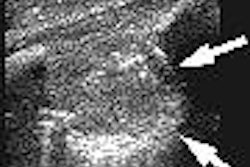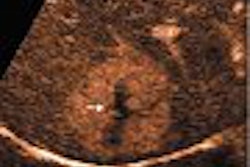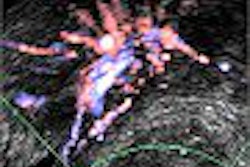ORLANDO, FL - Ultrasound-guided percutaneous pancreatic biopsies are safe and effective, according to research presented Monday at the annual convention of the American Institute of Ultrasound in Medicine (AIUM).
"Percutaneous pancreatic biopsy is safe with both FNA (fine-needle aspiration) and the biopsy gun and efficacious, with 96% adequate specimen yield," said Dr. Kedar Chintapalli of the University of Texas Health Science Center in San Antonio.
To determine the efficacy, yield, and safety of ultrasound-guided percutaneous pancreatic biopsies at a university teaching hospital, a research team from the University of Texas Health Science Center performed a retrospective review of the institution's abdominal intervention database. Twenty-three pancreatic biopsies performed on 21 patients were identified during a 36-month period from February 1, 2001, to January 31, 2004.
The patients had all received a prebiopsy CT scan. Ultrasound studies were performed using a HDI 5000 (Philips Medical Systems, Andover, MA) or a 128 XP (Siemens Medical Solutions, Malvern, PA) scanner.
Indications for biopsy included the presence of a pancreatic mass or fullness in 20 cases and dysfunction of transplant in three cases. Of the 23 biopsies, 16 (70%) were performed with 20-gauge FNA needles and seven (30%) were handled with an 18-gauge biopsy gun.
Adequate samples were obtained in 22 of 23 biopsies (96%). The average number of needle passes was 2.6, Chintapalli said. In 14 cases (61%), diagnosis was obtained by two passes.
Cancer was diagnosed in 12 (52%) cases. Nine (39%) biopsies yielded benign processes, including the three transplant cases, he noted.
In one FNA case, the sample was judged inadequate. A repeat biopsy was positive for malignancy, he said.
Another FNA produced a false-negative finding as later determined by biliary brushing, Chintapalli said. There was no significant difference between the core biopsy yield (100%) and the 20-gauge FNA needle (88%).
"The yield is better with the core biopsy than FNA but not statistically significant," he said.
Minor complications were found in two cases (8%), including a vasovagal reaction in a 60-year-old man. One pass was made with the 20-gauge FNA needle, with the diagnosis then made of cancer, Chintapalli said.
In the other complication, a 77-year-old woman with a cystic mass was diagnosed with pancreatitis (confirmed by CT), Chintapalli said. Neither patient required treatment for the complication, he said.
By Erik L. Ridley
AuntMinnie.com staff writer
June 22, 2005
Related Reading
Ultrasound-guided biopsy identifies outer prostate benign hyperplasia, April 15, 2005
US-guided core biopsy establishes malignancy in renal masses, August 22, 2002
Success of ultrasound-guided biopsy rests on patient positioning, March 20, 2002
Lidocaine decreases pain of ultrasound-guided needle biopsy of the prostate, February 11, 2002
Copyright © 2005 AuntMinnie.com



















